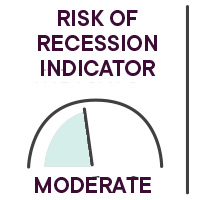Yann Furic
B.B.A., M. Sc., CFA®
Senior Portfolio Manager, Asset Allocation and Alternative Strategies
Strong economic growth
The United States is experiencing a significant economic recovery, boosted by the success of the vaccination campaign and consumer confidence. Inflation remains stable, as does the U.S. Federal Reserve’s key rate.
The situation is much the same in Canada. However, the inflation rate is expected to increase in the near future.
Focus on the past month

Overview of global equity markets*
- The flagship index of the Canadian stock market, the S&P/TSX, advanced 2.2% in February.
- In the United States, the S&P 500 gained 2.9% and the Nasdaq lost 3.0%.
- International stock markets were also in positive territory during the month, with the EAFE index up 0.73%.
- Emerging market equities rose 0.2% in April, while Chinese stocks were off 1.9%.
* All the percentages in this section are in Canadian dollars. Bloomberg unless otherwise indicated.
Key events
COVID-19 and vaccination campaigns
In the United States, there are numerous vaccination campaigns underway in different states and the speed with which vaccines are being distributed to citizens bodes well for the months to come. Globally, however, problems with the Johnson & Johnson and AstraZeneca vaccines point to a slowdown and desynchronized global growth. Regional fragmentation of this nevertheless vigorous growth can be expected.
Benchmark rates and central banks
Even though rates remain unchanged, there are high expectations for a recovery. The Fed is maintaining its target inflation rate of 2% before considering a hike. And before tightening its monetary policy, it added conditions: full employment, a stable recovery and above-target inflation.
For its part, the Bank of Canada kept its policy rate at 0.25%, while reducing its quantitative easing measures, which translated into a decrease in its bond purchases. This pushed the Canadian dollar above the US$0.80 mark.
Inflation: possibility or reality
Investors nevertheless expect inflation to rise faster than expected, considering the rapid improvement in the U.S. economy since the start of the year. Some even believe that inflation above 2% would be far from being a transitory phenomenon, but rather the new reality.
Retail sales on the rise
U.S. retail sales proved much stronger than expected, rising 9.8% in April versus the forecast of 5.8%.
Business results
The results of U.S. companies on the S&P 500 generally beat expectations. However, certain sectors are experiencing difficulties, in particular auto production, whose pace had to be slowed because of the global microprocessor shortage.
Employment situation
In the United States, job creation disappointed last month with just 266,000 new jobs, while the forecast was for 1 million. As participation in the labour market increased, the unemployment rate rose from 6% to 6.1%.
In Canada, 207,100 jobs were lost, versus expectations of 150,000. The partial return to lockdown in several Canadian provinces explains this decline, which should be temporary. The situation is expected to improve as more and more of the population gets vaccinated. The unemployment rate was 8.1%, as the labour force participation rate fell to 64.9% from 65.2% last month.
Results – Canadian bonds
Government of Canada bonds across maturities posted a negative return of 0.1% for the month. (Source: Canaccord Genuity)
Performance of our funds
View the returns

Our strategic monitoring
Main risks
Here are some risks that we are closely monitoring in the current environment.
- The cyclical recovery could be limited or delayed by the various problems affecting vaccine production.
- A variant that doesn’t respond to vaccination would have the same effect on the recovery.
- Inflation could rise sharply without economic growth, which would trigger an episode of stagflation.
- A sharp, rapid rise in interest rates would lower the price/earnings ratio, which would cause stock indices to fall.
- Governments could significantly increase corporate and personal tax rates to replenish their coffers. However, this scenario is unlikely in 2021.
Fundamental indicators
Some economic indicators that we continued to monitor in April:
Consumer confidence ![]()
For the second time since October, the Consumer Confidence Index remained above 100 in April.
U.S. personal savings ![]()
Already valued at around $1.5 trillion at the end of 2020, U.S. personal savings grew significantly thanks to various government assistance programs. This money is expected to be reinvested in the U.S. economy during the second half of 2021, as life gradually returns to normal.
Global Purchasing Managers’ Index ![]()
The index remains above 50, indicating an increase in purchasing managers’ intentions. Most countries are seeing higher purchasing intentions in the manufacturing sector.
Benchmark rates in Canada, Europe and the United States ![]()
Rates remain at low levels, which is favourable for an economic recovery. This situation should continue until their economies return to a satisfactory rate of growth and a low unemployment rate. For now, central banks are willing to let inflation exceed targets before tightening their monetary policies. However, rate hikes could come faster than expected a few months ago.
François Landry
CFA®
Vice-President and Chief Investment Officer
Vice-Chairman of the Board of Directors of Professionals' Financial - Private Management
Our strategies
(6-to-12 month horizon)
The reopening of economies should give new impetus to cyclical stocks and, to some extent, to emerging markets, which are more exposed to commodities.
In Canada, the S&P/TSX has a high weighting of cyclical stocks such as financials, basic materials, industrial products and energy. As for technology stocks, they should continue to benefit from the structural changes accelerated by the pandemic.
The strategic target of the FDP Tactical Asset Allocation Private Portfolio is 65% equities and 35% bonds. In light of recent market movements, the equity weighting was increased to 68% and the bond weighting reduced to 32%.
The geographic allocation of equities in our portfolios remained the same. The equity weighting is neutral with no regional deviation, since the expected return is roughly the same in all cases. However, sector or factor positioning varies from one region to the next.
- In terms of Canadian equities, we have had a favourable bias towards banks for several months and we maintained our exposure to financial services.
- As for U.S. equities, our exposure to technology stocks and industrial products remained unchanged. These sectors should benefit from announced infrastructure spending and the global economic recovery.
- As far as EAFE (Europe, Australasia, Far East) equities are concerned, we maintained our neutral position due to the fiscal and monetary measures introduced in Europe, which are less aggressive than those implemented in North America. The zone should benefit from an increase in commodity prices.
François Landry, CFA
Vice-President and Chief Investment Officer
Yann Furic, B.B.A., M. Sc., CFA
Senior Portfolio Manager, Asset Allocation and Alternative Strategies
Sources: Bloomberg
The opinions expressed here and on the next page do not necessarily represent the views of Professionals’ Financial. The information contained herein has been obtained from sources deemed reliable, but we do not guarantee the accuracy of this information, and it may be incomplete. The opinions expressed are based upon our analysis and interpretation of this information and are not to be construed as a recommendation. Please consult your Wealth Management Advisor.










